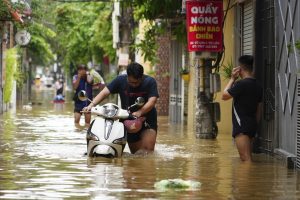The Japan Meteorological Agency first spotted the low-pressure system near the Pacific island nation of Palau.
Tsuboki Kazuhisa, an expert on tropical cyclones at Nagoya University, warned that the storm had undergone rapid intensification as it hovered over a patch of “warmer-than-usual” water in the South China Sea. Named Yagi (meaning goat), the system doubled in size after exiting the Philippines, where it made landfall as a tropical storm on September 2.
Joint Typhoon Warning Center in Hawaii later confirmed that the cyclone briefly hit Category 5 status (160 mph winds) while it was still offshore.
Typhoon Yagi made multiple landfalls across Asia in September, leaving a trail of destruction from Manila to Mandalay. More than 750 people died and damages across the region were estimated at upwards of $15 billion, making Yagi one of the costliest cyclones on record.
The typhoon was Vietnam’s most destructive storm in decades. Haiphong, a leading export hub in the Red River Delta, took a direct hit. The typhoon’s 149 kph winds blew away facades and roofs of buildings in and around the port city. In Ha Long Bay, a high-traffic tourist area, more than 20 tour boats sank and 2,250 aquaculture facilities were washed away. The owner of a fish farm told Nikkei Asia, “Yagi destroyed all of us.”
The typhoon crippled supply chains across the Red River Delta, which includes the capital Hanoi. The region generates 35 percent of Vietnam’s export revenues. In a survey of 216 companies, 80-90 percent faced power outages and communications disruptions. Samsung, the country’s largest foreign investor, reported waterlogging in one of its facilities. However, the factory in Thai Nguyen, which ships the bulk of the company’s global smartphone output, was not affected.
Although coastal areas suffered extensive property damage, fatalities were higher in Vietnam’s mountainous northwest. The remote hamlet of Lang Nu was wiped out by a flash flood. One resident told the AFP she looked out of her window and saw “a huge amount of land coming towards me.” She survived by clinging to a concrete pole as her wooden stilt house was washed away in the deluge.
Yagi inundated Laos and Thailand with historic downpours. Parts of Chiang Rai province in northern Thailand suffered their worst flooding in 80 years. In some districts, conventional relief efforts by boat floundered due to strong currents, and jet skis were pressed into service to save flood victims. Videos of jet ski rescues in northern Thailand were widely shared on social media.
In Myanmar’s Mandalay Region, survivors escaped flash floods on the backs of elephants. The capital Naypyidaw was among the worst affected areas with heavy damage to infrastructure. Deputy Prime Minister Vice Senior Gen. Soe Win described the flooding in the capital as unprecedented.
Myanmar’s death toll of 384 was the highest in Southeast Asia. Dr. Win Myat Aye, a minister in the opposition National Unity Government (NUG) told The Irrawaddy that NUG’s estimates showed casualties “will be over 1,000” with one village in the Mandalay Region alone reporting 800 people either dead or missing. The military government’s unexpected request for foreign aid was further evidence of the gravity of the humanitarian crisis.
An editorial in the state-run Global New Light of Myanmar was obliquely critical of the government’s rescue efforts: “The impact of Typhoon Yagi varied significantly between countries based on their level of preparation. Nations with robust disaster preparedness were able to mitigate the impact, while those lacking adequate measures suffered severe consequences.”
The typhoon eventually fizzled out as a depression over northern India. Yagi left a “positive impact” bringing “beneficial” showers to drought-prone states along its path. India Today called the remnants of the system a “rare” meteorological event that marked the tail end of an “extraordinary journey” from the Pacific Ocean to the foothills of the Himalayas.

































